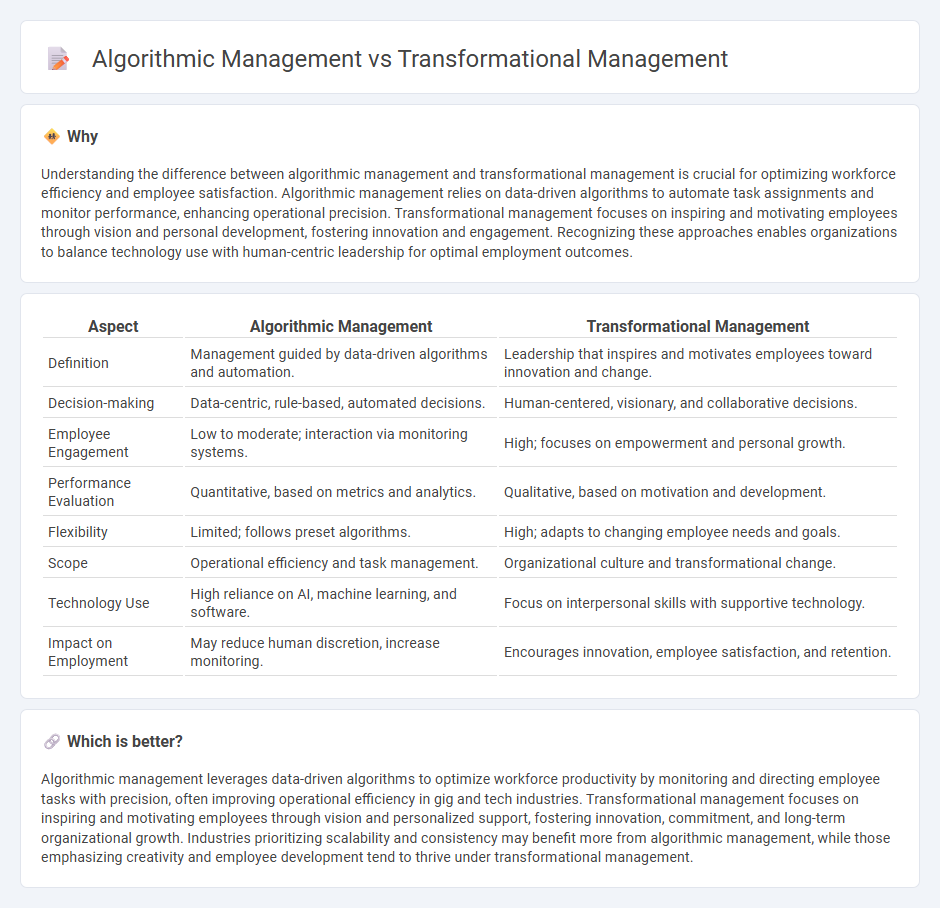
Algorithmic management utilizes data-driven algorithms and automated processes to monitor, evaluate, and optimize employee performance, ensuring consistency and efficiency in task execution. Transformational management focuses on inspiring and motivating employees through vision, empowerment, and personal development to foster innovation and engagement. Explore the key differences and impact of these management styles on modern workforce dynamics.
Why it is important
Understanding the difference between algorithmic management and transformational management is crucial for optimizing workforce efficiency and employee satisfaction. Algorithmic management relies on data-driven algorithms to automate task assignments and monitor performance, enhancing operational precision. Transformational management focuses on inspiring and motivating employees through vision and personal development, fostering innovation and engagement. Recognizing these approaches enables organizations to balance technology use with human-centric leadership for optimal employment outcomes.
Comparison Table
| Aspect | Algorithmic Management | Transformational Management |
|---|---|---|
| Definition | Management guided by data-driven algorithms and automation. | Leadership that inspires and motivates employees toward innovation and change. |
| Decision-making | Data-centric, rule-based, automated decisions. | Human-centered, visionary, and collaborative decisions. |
| Employee Engagement | Low to moderate; interaction via monitoring systems. | High; focuses on empowerment and personal growth. |
| Performance Evaluation | Quantitative, based on metrics and analytics. | Qualitative, based on motivation and development. |
| Flexibility | Limited; follows preset algorithms. | High; adapts to changing employee needs and goals. |
| Scope | Operational efficiency and task management. | Organizational culture and transformational change. |
| Technology Use | High reliance on AI, machine learning, and software. | Focus on interpersonal skills with supportive technology. |
| Impact on Employment | May reduce human discretion, increase monitoring. | Encourages innovation, employee satisfaction, and retention. |
Which is better?
Algorithmic management leverages data-driven algorithms to optimize workforce productivity by monitoring and directing employee tasks with precision, often improving operational efficiency in gig and tech industries. Transformational management focuses on inspiring and motivating employees through vision and personalized support, fostering innovation, commitment, and long-term organizational growth. Industries prioritizing scalability and consistency may benefit more from algorithmic management, while those emphasizing creativity and employee development tend to thrive under transformational management.
Connection
Algorithmic management leverages data-driven algorithms to monitor and optimize employee performance, while transformational management focuses on inspiring and motivating employees towards innovation and change. Both approaches intersect by using technology and leadership principles to enhance workforce productivity and engagement. Integrating algorithmic insights with transformational leadership strategies fosters a dynamic work environment that balances efficiency with employee empowerment.
Key Terms
Leadership Style
Transformational management emphasizes inspiring and motivating employees through vision, creativity, and individualized support to drive innovation and change. Algorithmic management relies on data-driven, automated processes and performance metrics to guide decision-making and monitor employee productivity. Explore more to understand how these contrasting leadership styles impact organizational effectiveness and employee engagement.
Decision-Making Process
Transformational management emphasizes adaptive decision-making, empowering employees to contribute ideas and fostering innovation through collaborative problem-solving. Algorithmic management relies on data-driven, automated decision-making systems that optimize operational efficiency and enforce standardized procedures. Discover how these contrasting approaches impact organizational agility and employee engagement.
Employee Autonomy
Transformational management emphasizes empowering employees through motivation, creativity, and personal growth, fostering higher autonomy and engagement. Algorithmic management relies on data-driven algorithms to monitor and control tasks, often limiting employee autonomy by enforcing strict guidelines and real-time performance tracking. Explore how these contrasting approaches impact workforce satisfaction and productivity for deeper insights.
Source and External Links
What is Transformational Leadership? - Transformational leadership is a style focusing on inspiring and motivating employees to innovate and contribute to the organization's vision through empowerment, creativity, and long-term adaptability, characterized by the four I's: idealized influence, inspirational motivation, intellectual stimulation, and individualized consideration.
What Is Transformational Leadership? | National University - Transformational leadership empowers organizations by increasing employee engagement, improving financial outcomes, boosting performance, strengthening team relationships, and lowering employee turnover through motivation and personal growth.
Transformational leadership - Transformational leadership positively affects organizational effectiveness by inspiring followers to exceed expectations through vision and creativity, distinctly different from managerial roles that focus on task execution and control.
 dowidth.com
dowidth.com